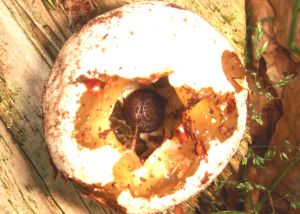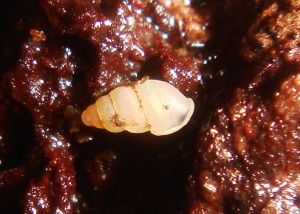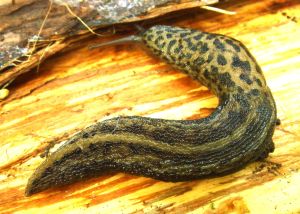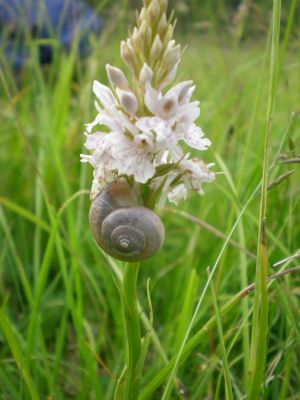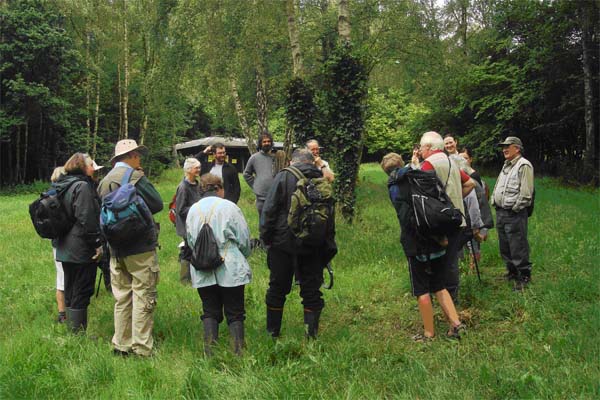
Group a Crab Wood being briefed by June (Photo: Bas Payne)
|
The field meeting to Crab Wood and West Wood, Winchester, Hampshire on 13 June 2009 was well attended with 18 present (including the Leader, June Chatfield). Ten were Conchological Society members, five from the Southampton Natural History Society and three from National Museum Wales in Cardiff. It is useful to combine with other groups in these meetings. Crab Wood is classic collecting country, being an ancient woodland on chalk and clay-with-flints near Winchester. It was one of the early collecting sites of the famous conchologist J R le B Tomlin when he was a scholar at Winchester College (1878 - 1883). Specimens from “Crabbe Wood”, especially Helicodonta obvoluta, the Cheese Snail, are in the Melville-Tomlin Collection at the National Museum Wales so this meeting was of special interest to the Cardiff team who collected some specimens of various molluscs for DNA work, a technique not available to Tomlin in the nineteenth century. For the Conchological Society field meeting the weather was pleasantly warm and sunny, but although the ground had been moistened by rain the previous week , there had not been enough of it and the molluscs were mostly hidden away under logs and in crevices and had to be actively searched for with much log-rolling and litter sifting. This extensive block of woodland is owned by Hampshire County Council and managed for conservation interests by the Countryside Section as part of the Farley Mount Country Park. There is open access via a network of paths and rides. The western section north of the Roman Road (Sarum Road) is leased to the Forestry Commission and although there are some conifer plantations, there are considerable stretches of beech plantations about 60 years old to support old woodland molluscs. Crab Wood (41/43-29-and 41/44-29-)The morning was spent in the eastern section (Crab Wood) on either side of the north/south road to Sparsholt. This area has a thicker layer of clay-with-flints covering the chalk and has been traditionally managed as oak, ash and beech standards with hazel coppice. Hampshire County Council is bringing rotational coppicing back to increase open areas and glades to benefit wild flowers and butterflies. Some ancient beech trees, probably originally pollarded, survive in this wood giving mature and old trees, while dead wood is left in situ for insects and fungi as well as molluscs. Part of the wood is included in the Reserves Handbook of the Hampshire and Isle of Wight Naturalists’ Trust. West Wood (41/41-29- and 41/41-30-)The afternoon was spent in West Wood on the Forestry Commission plantations. This area is on the side of the hill and chalk is exposed. At our furthest point a large pile of harvested logs provided a focus for searching and here the chalk was not covered in clay-with-flints and a calcium source was more accessible to snails. Further cover was provided in the beech leaf-litter. RecordsThirty four species of molluscs were found, which is typical for an old woodland on chalkland of southern England. Eleven species were slugs, the rest snails. The richest collecting was in the Well Copse area of West Wood that was the main focus for the old woodland species of Helicodonta obvoluta (Cheese Snail) and Limax cinereoniger (Ash-black Slug). The highlight of the meeting was the finding of the Cheese Snail, a rare species in Britain with a distribution concentrated in the western part of the South Downs of West Sussex and Hampshire, of which West Wood is the western-most limit nationally. It was also the focus of some of Tomlin’s collecting in this block of woodland and he refers to Helicodonta obvoluta in a paper that was presented to the Winchester College Natural History Society and published by the College (Tomlin 1882), but he found the snail elusive: The best place to look for living specimens is in old decayed stumps covered with ivy; but it is always difficult to find, and though I have hunted often in Crabbe Wood have seldom pitched upon a fortunate spot. West Wood is the section furthest away from Winchester College and Tomlin would have visited on foot from College in a limited slot of time and it is doubtful whether the boys were given much free time. His paper shows his preference for the shelled molluscs as he does not expand on slugs: This latter class consists of the common slugs, or Limacidae, which I will dismiss at once, as the aspect and much less handling of these slimy creatures cannot be considered especially inviting. I am sure the majority of my hearers will share in this opinion. It is interesting to see in the report of the discussion that one, F A Bather, did not agree: He deprecated the author’s want of enthusiasm with regard to slugs. Another comment on Tomlin’s paper in The Wykehamist (No. 166, May 1882) was: The paper was concise and to the point but abounded in long words, even more than the nature of the subject warranted.
On the Conchological Society field meeting Helicodonta obvoluta was only found in the north-west section of West Wood under a stacked pile of forestry logs and other dead wood. About eight living specimens were found and some dead shells. There were juveniles with bristly hairs on the shells as well as adults, demonstrating a breeding population still present 127 years after Tomlin’s searches in Crab Wood. On an earlier occasion, when the wood was wet from all night rain and the atmosphere warm and humid, I have seen as many as 60 Cheese Snails active and crawling on the trunks of the young (60 year old) beech trees of Well Copse. It was noticeable that they favoured trunks that had a black crust of the fungus Aschodichaena rugosa and David Lonsdale of the Alton Natural History Society and former mycologist for the Forestry Commission, had previously seen snails (Clausilia bidentata) feeding on this fungus on beech trunks. A discovery of interest on the field meeting, also associating snails and fungi, was an egg of the Common Stinkhorn (Phallus impudicus) that had been hollowed out and had a Cheese Snail in residence. About four specimens of the large slug Limax cinereoniger with a black and white striped foot sole were found under logs in the same area as the Cheese Snails. I took a sample of beech leaf-litter from the Cheese Snail area (41/41675 30010) to sort at home. This was dominated by the small white Three-toothed Herald Snail Carychium tridentatum (35) with smaller numbers (1-5) of Acanthinula aculeata, Punctum pygmaeum, Discus rotundatus, Cochlodina laminata, Oxychilus alliarius, Aegopinella nitidula, A. pura and Clausilia bidentata. Tomlin’s paper to the Winchester College Natural History Society in 1882 was a general one introducing the local molluscs and it is not possible to derive a complete list for Crab Wood from it as no localities were given for very common species. Mention is made of Acanthinula aculeata, Balea perversa, Carychium tridentatum, Helicigona lapicida, Helicodonta obvoluta, Macrogastra rolphii, Merdigera obscura, Pomatias elegans and seven species of zonitids not specified but three of these are not on our list. When official field meetings are arranged about a year in advance, we take our chance on the weather and June 2009 was dry. Tomlin himself commented that Helicigona lapicida and Merdigera obscura were abundant only after rain and Balea perversa needs dampsness and shade. Opportunist searches in the appropriate weather will be necessary to find them together with further sampling of leaf-litter for some of the smaller species that were absent. List of species from the Winchester field meeting
AcknowledgementI am grateful to John Glasgow for researching and copying the references to Tomlin’s work on snails in reports and archives of Winchester College. ReferencesANON, 1882. Natural History Society The Wykehamist No. 166, 67. TOMLIN, J R le B, 1882. Land and Freshwater Shells of Winchester Winchester College Natural History Society 6th Report 1882, 44-47. |
Helicodonta obvoluta in West Wood. Ventral view showing umbilicalus and folds in mouth of shell. (Photo: Bas Payne) Helicodonta obvoluta in West Wood. (Photo: Bas Payne)
Juvenile Helicodonta obvoluta in West Wood with hairs. (Photo: Bas Payne)
Helicodonta obvoluta in West Wood in "egg" of Phalus impudicus (Photo: Bas Payne) Log rolling at West Wood (Photo: Bas Payne) Harriet Wood photographing in Crab Wood (Photo: Bas Payne)
Carychium tridentatum (Photo: Bas Payne)
Limax maximus (Photo: Bas Payne) Adrian Norris identifying the catch (Photo: Terry Wimbledon) Boettgerilla pallens (Photo: Bas Payne)
Monacha cantiana on Common Spottd Orchid at edge of West Wood (Photo: Graham Long) |


